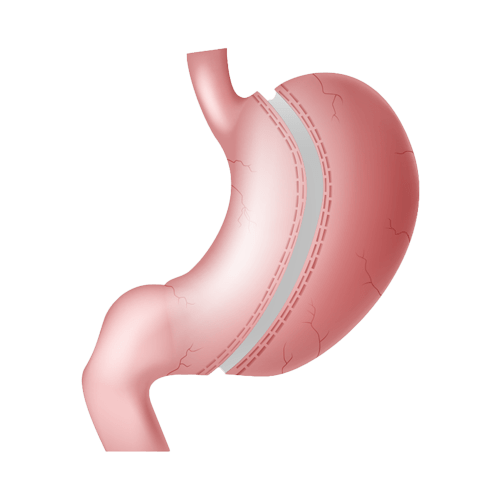Laparoscopic &
Bariatric Surgery
Laparoscopic or Minimally Invasive Surgery
The term bariatric surgery or metabolic surgery is used to describe weight loss surgery. It also explains how these operations affect the health and weight of patients’ metabolisms. In addition to obesity, these operations are specifically helpful in treating diabetes, high blood pressure, sleep apnea, and high cholesterol, among many other disorders. These procedures can also help to reduce the risk of future health issues. In addition, patients with obesity who opt to receive therapy might expect a higher quality of life.
Metabolic and bariatric procedures have been fulfilled over many decades and are among the most thoroughly researched treatments in modern medicine. They are conducted utilising minimally invasive surgical techniques and tiny incisions. These developments enable patients to have a better overall experience, less pain, fewer problems, shorter hospital stays, and faster recovery times. In addition, these procedures are incredibly safe, with minimum complication rates than typical procedures, including hysterectomy, gallbladder removal, and hip replacement.
The purpose of these procedures is to make the stomach and intestines help in reducing obesity and other disorders. The operations may cause the stomach to shrink and a part of the intestine to be bypassed. This leads to a decrease in food intake and a change in how the body absorbs food for energy, reducing hunger and more fullness. In addition, these procedures help the body obtain and maintain a healthy weight.
The procedures for bariatric surgery are listed and explained below. However, each operation has its own set of benefits and cons. Ou bariatric surgeon will go over your medical history with you and help you decide which procedure is right for you.
Weight Loss Procedures at Horizon Hospital

Roux-en-Y Gastric Bypass
This procedure mostly ignores the first part of the stomach and small intestine. A small abdominal pouch is made using a surgical stapler. The rest of the abdomen is not removed, but closed. The pouch limits the amount of food so you can only eat a small amount at a time.
The small intestine is divided and one end is raised and attached to the abdominal sac, called a gastrojejunostomy. The other end of the small intestine, which is still attached to the remnants of the stomach, is reconnected to the other part of the intestinal tract, called a genitourinary gynecostomy.
Mini-Gastric Bypass
Mini-gastric bypass surgery is performed under general anaesthesia. Your surgeon will make several small incisions in your abdomen. The laparoscope, a thin device with a light and camera at the end, is inserted through an incision, allowing your surgeon to clearly see the internal organs on the monitor. Small surgical instruments are inserted through other incisions. The first step during surgery is to reduce the size of the stomach so that it contains less food. The abdomen turns into a long, thin pouch that extends through the sterling to the inner part. The second stage of the surgery involves making a bypass to eat from the new abdominal sac. A loop of the small intestine is preferably selected for anastomosis between 150 and 250 cm, depending on the surgeon and the patient’s metabolic condition. The middle part of the intestine is connected to the opening in the abdominal sac called the “omega loop”. The loop enables the food to ignore the lower abdomen, duodenum and small intestine.


Sleeve Gastrectomy
Only your abdomen is involved in this operation. A short sleeve, or tight pouch, is made using a surgical stapler to separate the abdomen. After the sleeve is made, the remaining abdomen about two-thirds of the abdomen is removed. The sleeves create a feeling of fullness quickly and reduce appetite. Only a small amount of food can pass through the sleeve at a time.
Benefits of sleeve gastrectomy include:
No foreign bodies were implanted.
There is no recurrence of the intestinal tract.
The average weight loss is higher than the gastric band, but slightly lower than the gastric bypass.
Disadvantages of sleeve gastrectomy include:
Short-term data are available on sleeve gastrectomy results.
Risk of getting to the baseline of the abdomen.
Laparoscopic or Minimally Invasive Surgery
Laparoscopic surgery, also called non-invasive surgery, involves inserting a small video camera and abdominal surgery with a few cuts. The surgeon can no longer view camera images during surgery. In a general open surgery, the surgeon cuts a long time to open the abdomen.
The American Society for Bariatric Surgery recommends that laparoscopic weight surgery be performed only by experienced surgeons in both laparoscopic and open bariatric procedures. At UCSF Bariatric Surgery Center, our specialists are trained in the advanced techniques needed to perform laparoscopic procedures.
Laparoscopic surgery is considered uncommon because it replaces a major surgical need. Studies show that laparoscopic weight surgery has several benefits for patients compared to open surgery.
Our Doctors

Dr Amjad Saeed
CONSULTANT GENETRAL & BARIATRIC SURGEON

Dr. Awais Amjad Malik
CONSULTANT SURGICAL ONCOLOGIST
